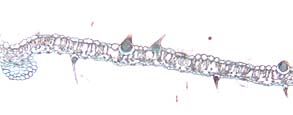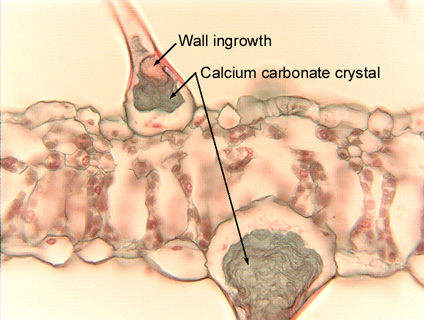Up
Ordinary epidermis
Guard cells
Thick cuticle
Thicker cuticle
Thin cuticle
Parasitic plant
Petal epidermis
Sclerified epidermis
Papillose epidermis
Sculptured cuticle
Elaborate cuticle
Cuticular horns
Radial walls
Cuticle proper
No epidermis
Epidermal peels
Cycad peel
Paradermal
Typical stoma
Sunken stoma
Stomatal orientation 1
Unusual orientation 2
Artifact
Stomata and fibers
Stomatal crypts
Crypts, mag.
Crypt margin
Non-crypt
Water lily
Stomatal channels
Groove, hi mag
Subsidiary cells
Ledges
Papillae
Trichome
Uniseriate hair
Peltate hair, mag
Peltate, lo mag
Branched hairs
Trichome base
Lithocyst, Ficus
Lithocysts, hemp
Bulliform cells
Grass epidermis
Multiple epi
Uniseriate?
Peperomia
| |
 Fig.
10.5-2. Transverse section of leaf of hemp (also marijuana; Cannabis
sativa). The epidermis of this hemp leaf has numerous lithocysts that protrude out from the leaf, rather than into
the leaf like the lithocysts of Ficus. Fig.
10.5-2. Transverse section of leaf of hemp (also marijuana; Cannabis
sativa). The epidermis of this hemp leaf has numerous lithocysts that protrude out from the leaf, rather than into
the leaf like the lithocysts of Ficus.
In the high magnification view, the
wall ingrowth is visible. Calcium carbonate does not begin
crystallizing in the cytoplasm or vacuole, but only at the surface of this wall
ingrowth. In the lower lithocyst, the calcium carbonate has grown into a large
cystolith that it occupies most of the cell. Notice that the section is very
thick (the mesophyll of the leaf has many out-of-focus cells in the background);
because lithocysts are so large and the wall ingrowth is so small, there is a
higher probability of catching an ingrowth in a thick section compared to a thin
section.
|
 Fig.
10.5-2. Transverse section of leaf of hemp (also marijuana; Cannabis
sativa). The epidermis of this hemp leaf has numerous lithocysts that protrude out from the leaf, rather than into
the leaf like the lithocysts of Ficus.
Fig.
10.5-2. Transverse section of leaf of hemp (also marijuana; Cannabis
sativa). The epidermis of this hemp leaf has numerous lithocysts that protrude out from the leaf, rather than into
the leaf like the lithocysts of Ficus.
